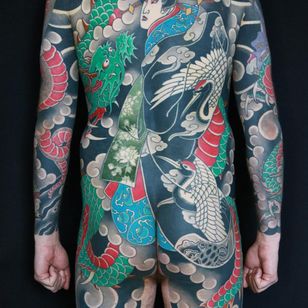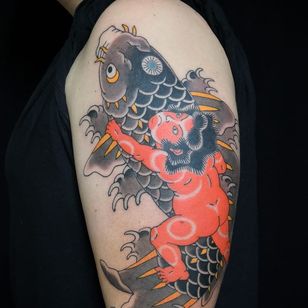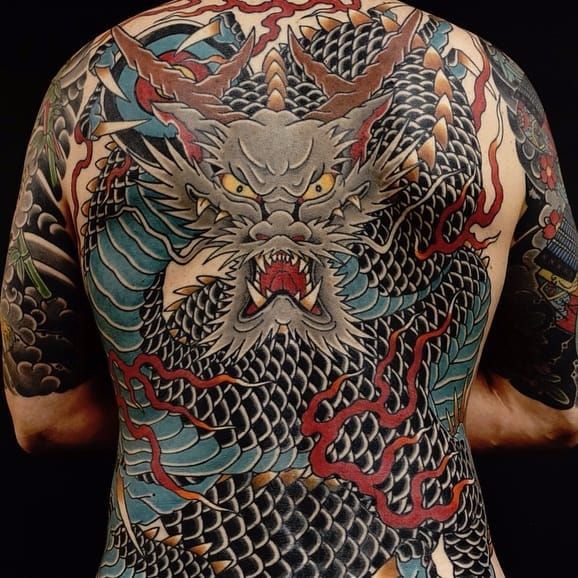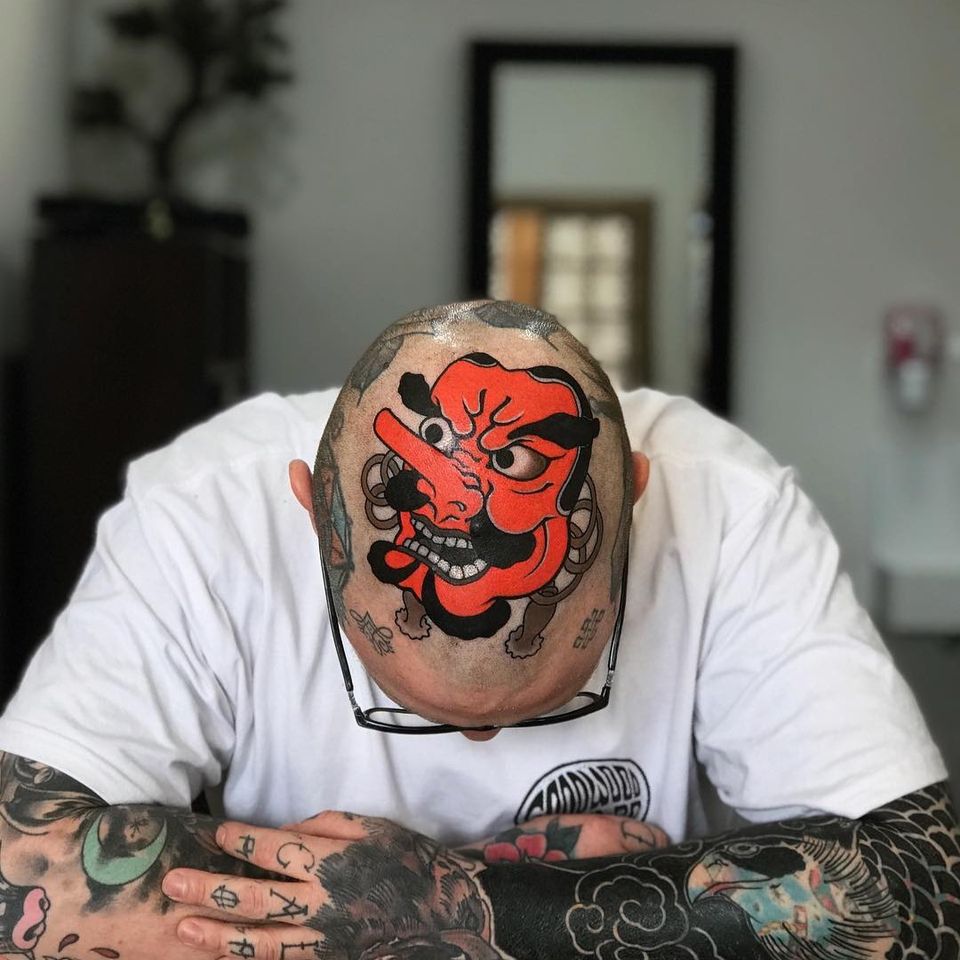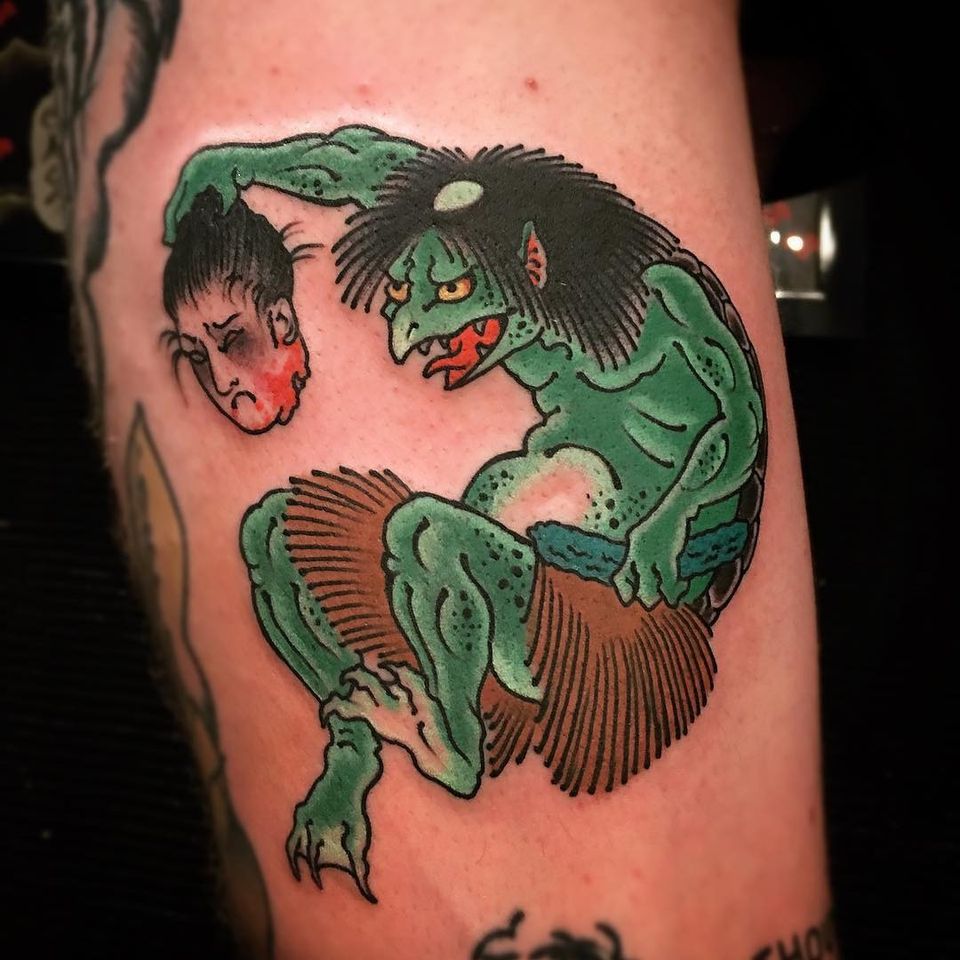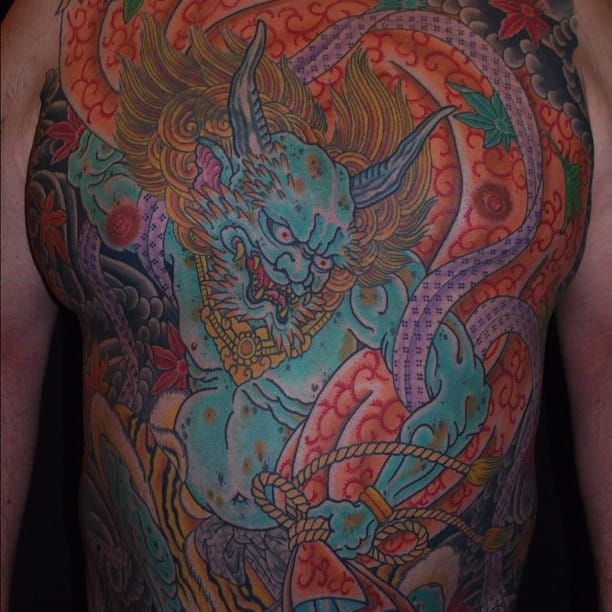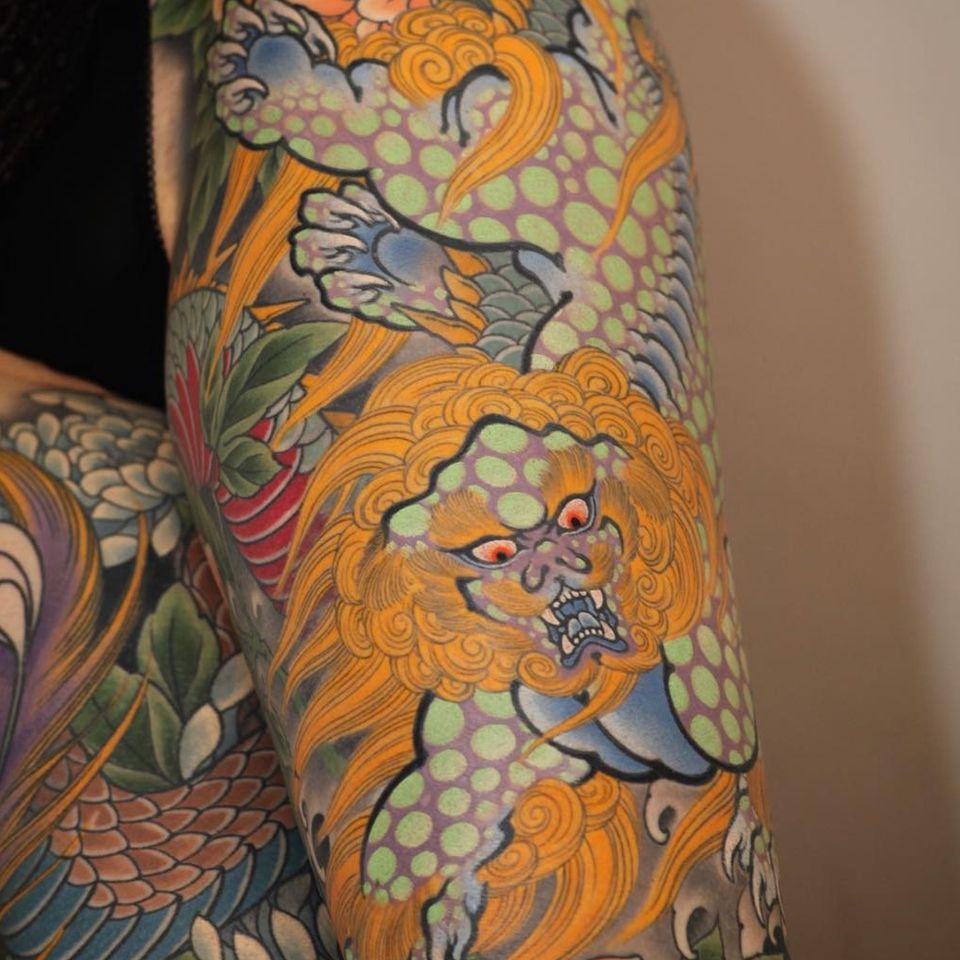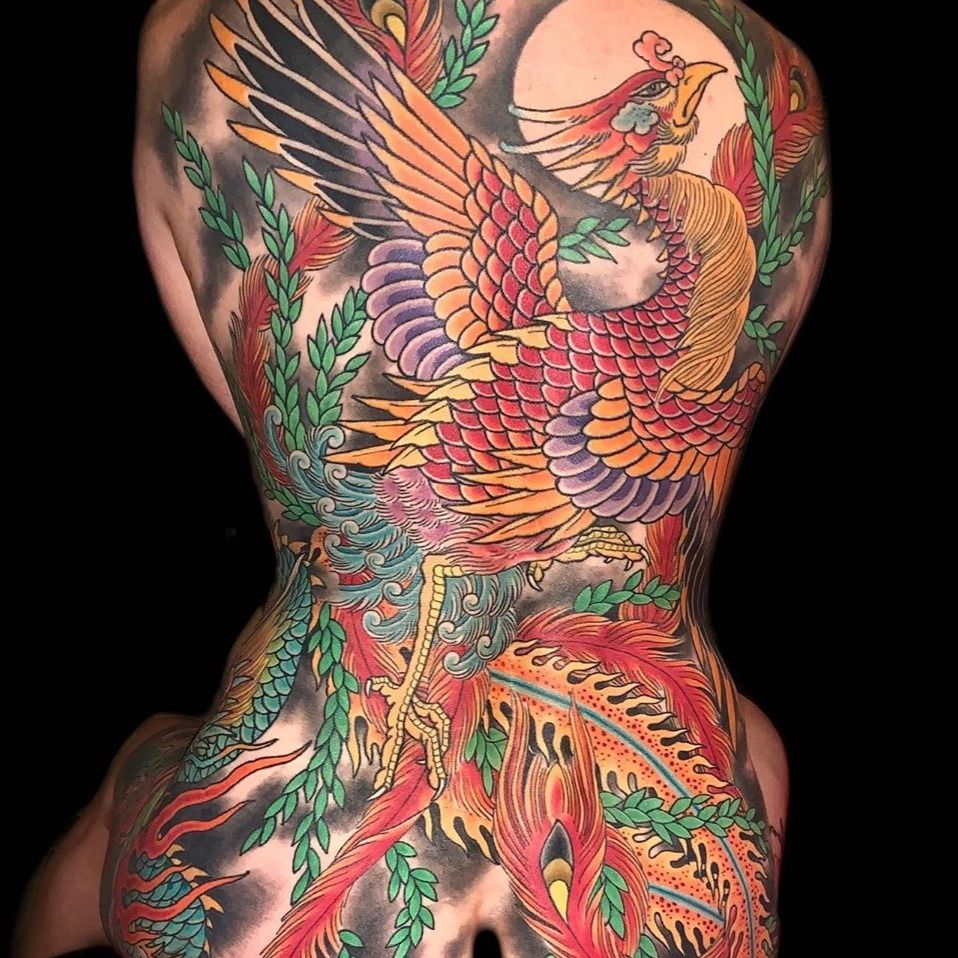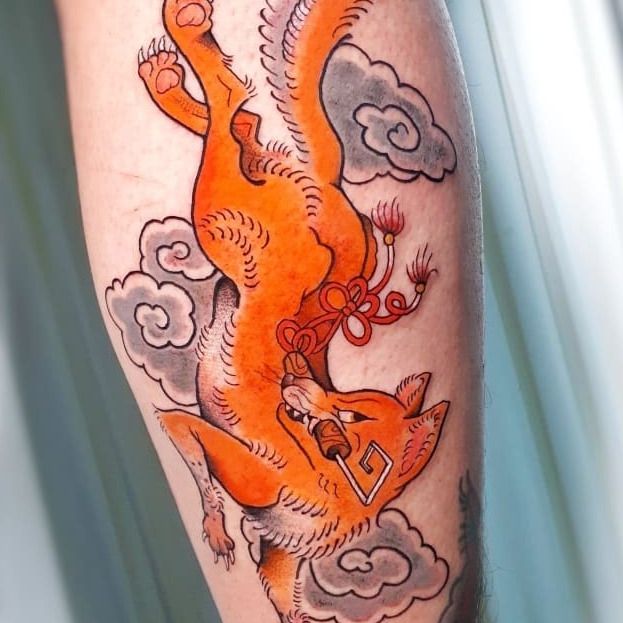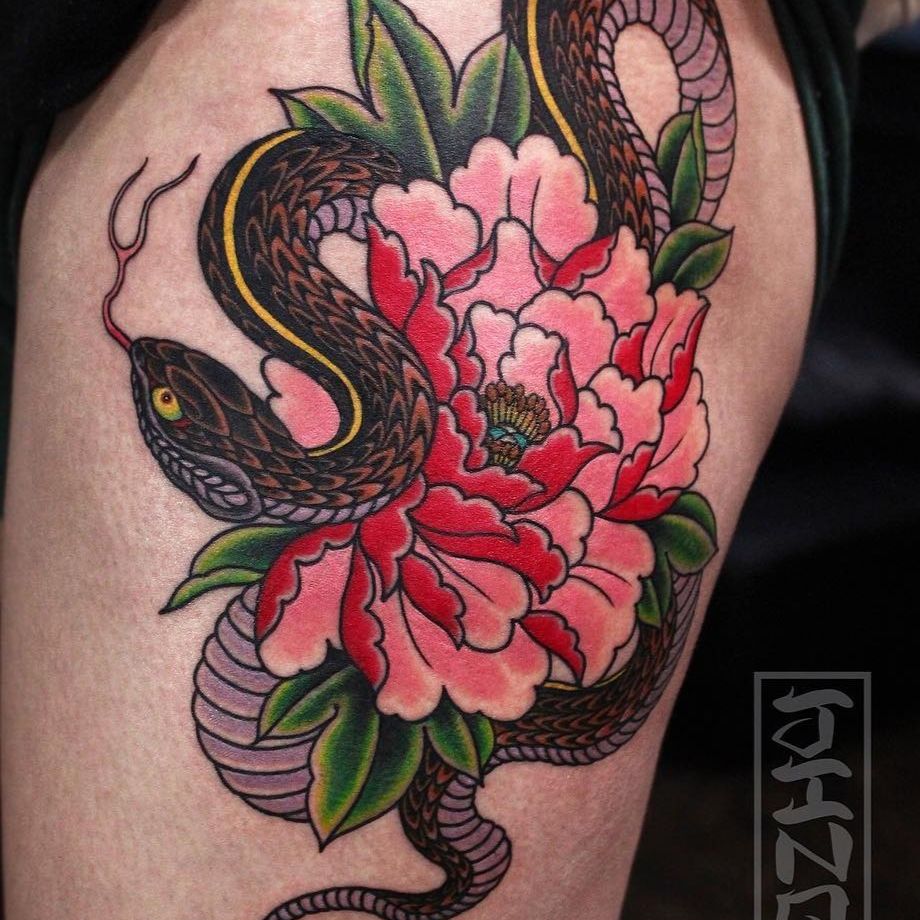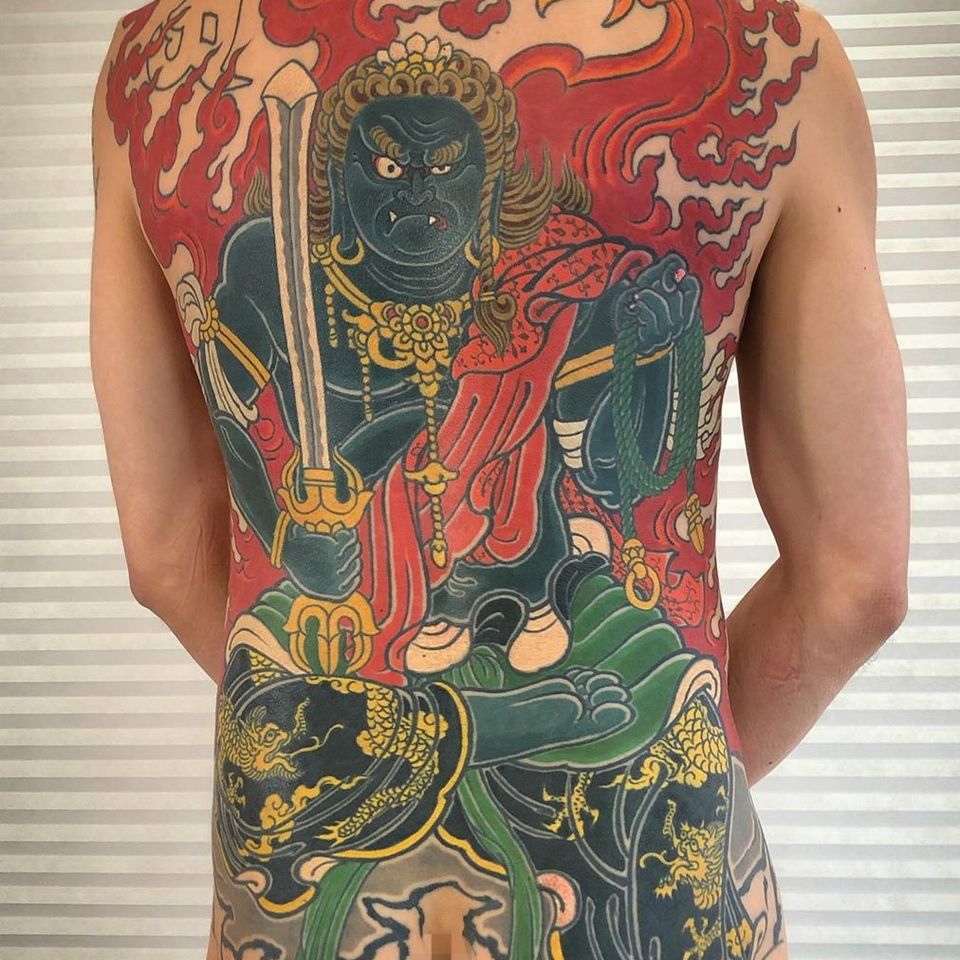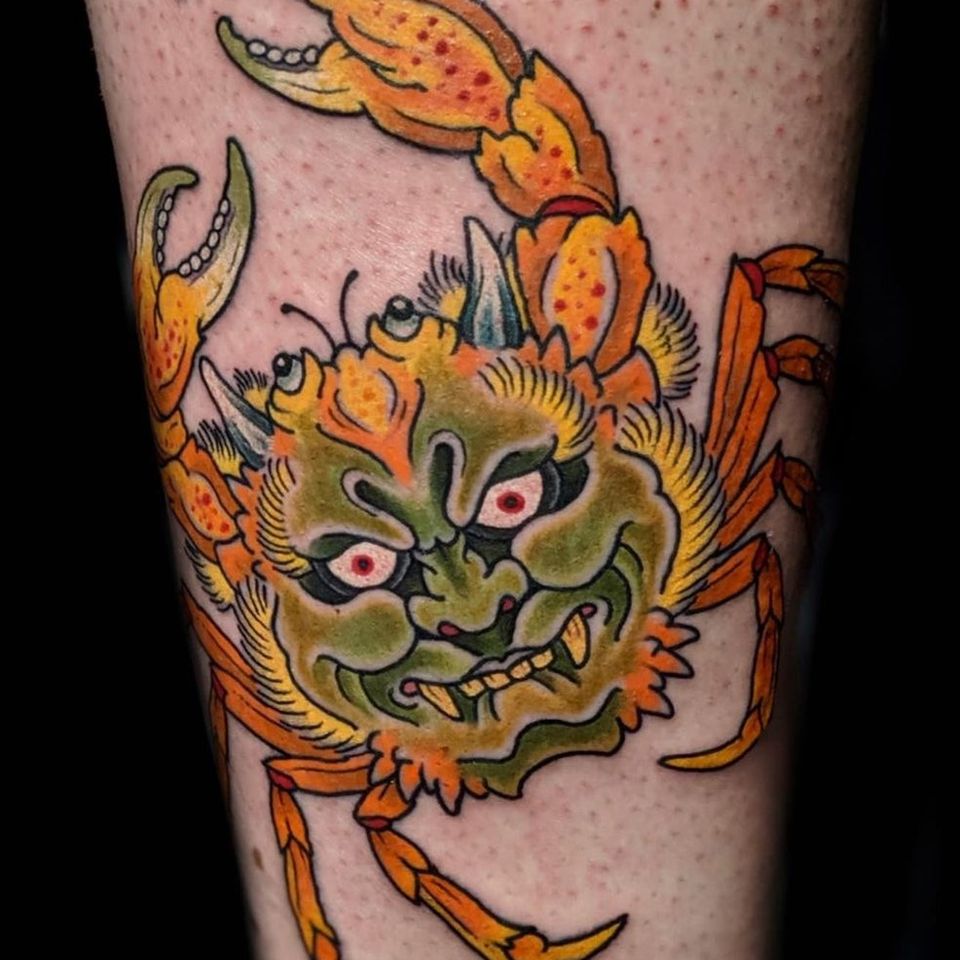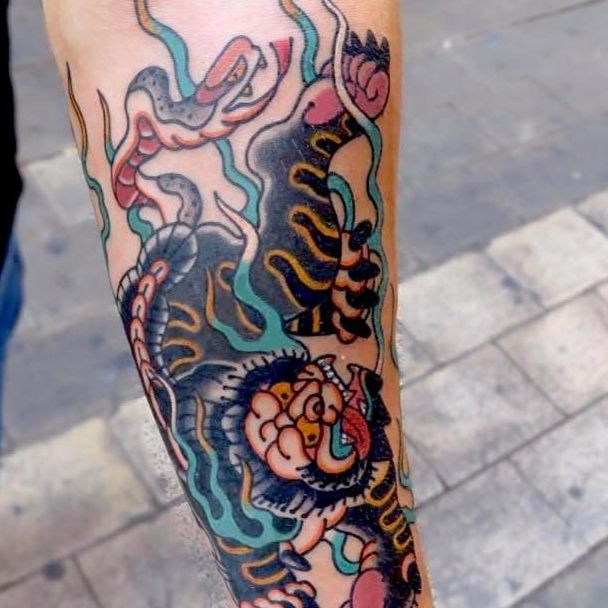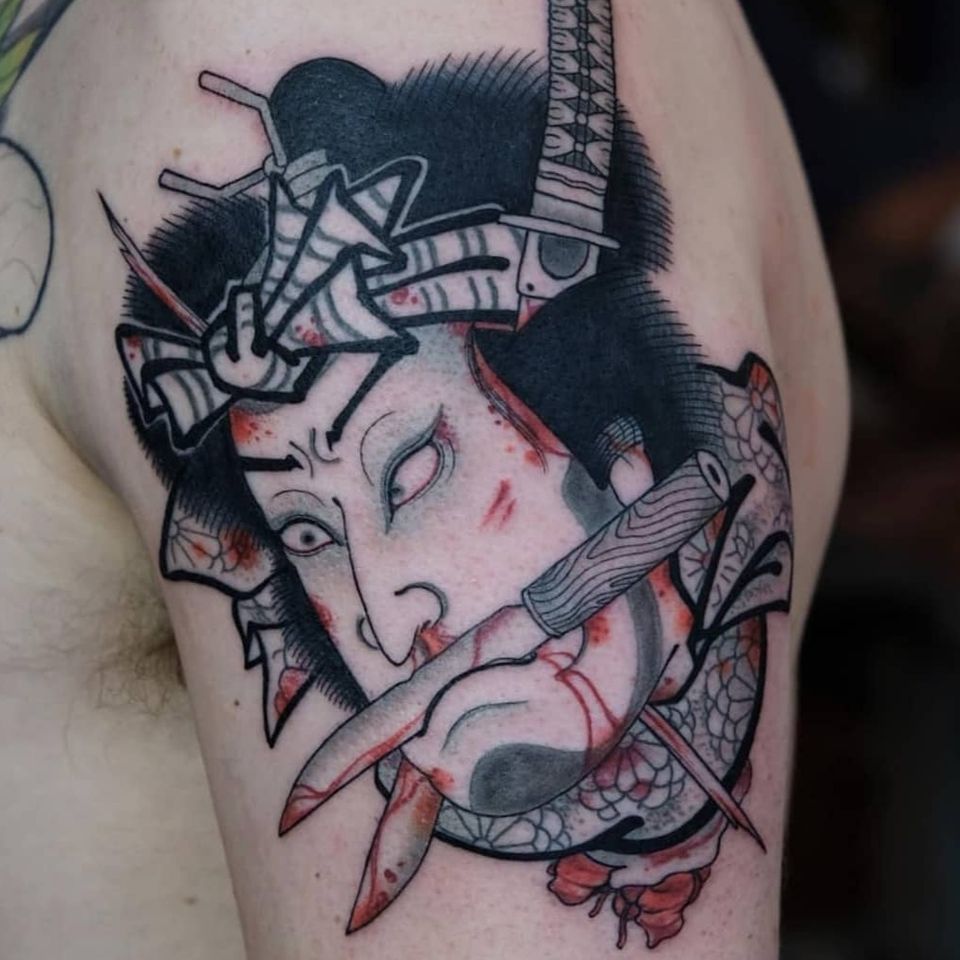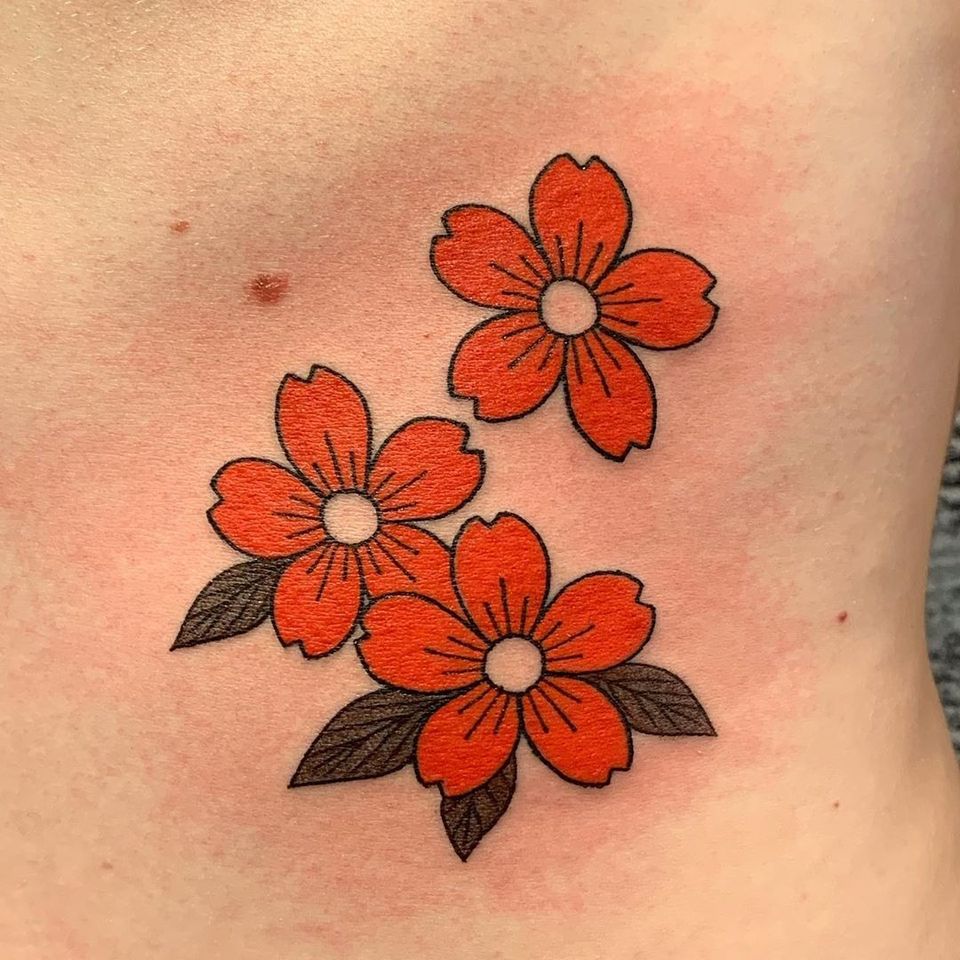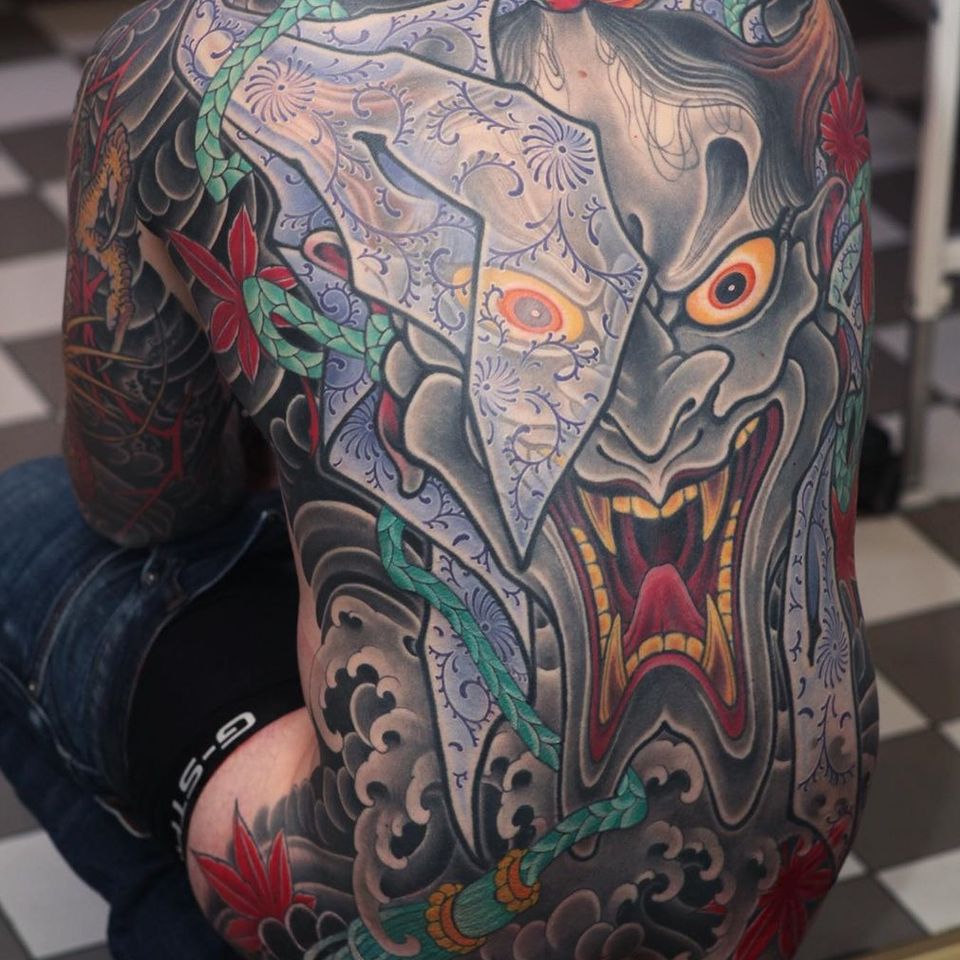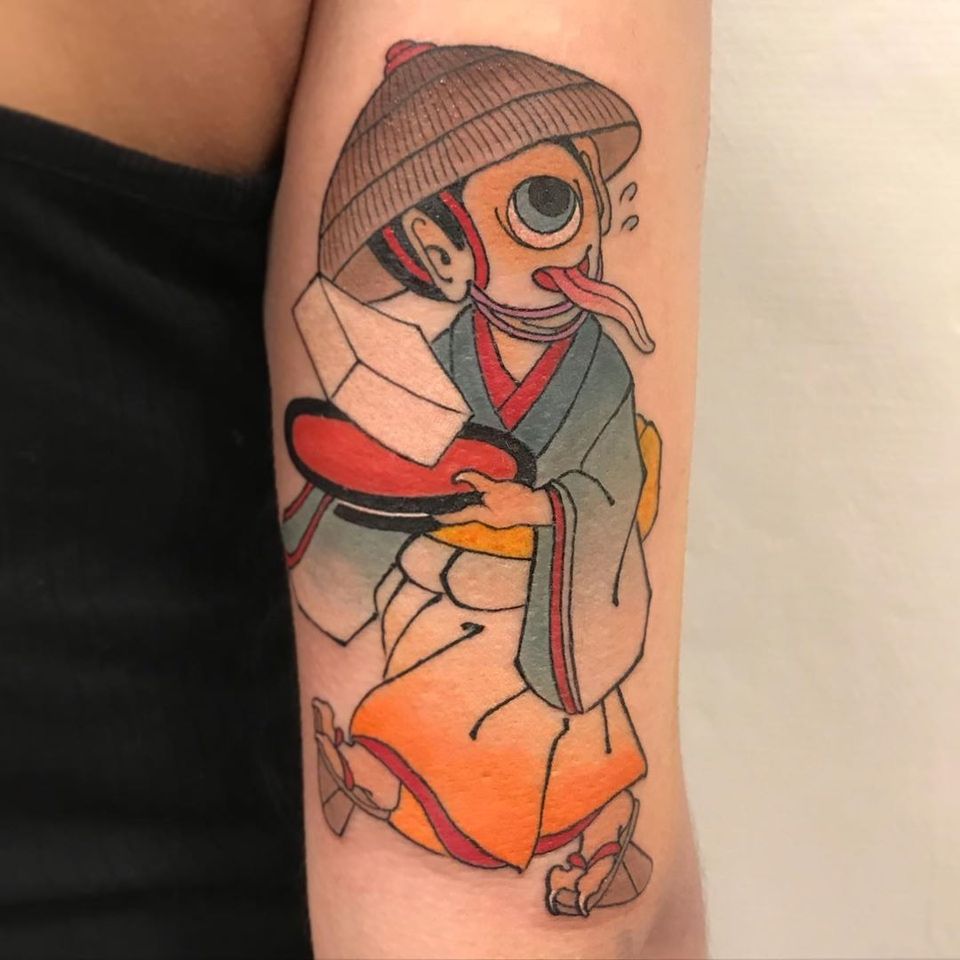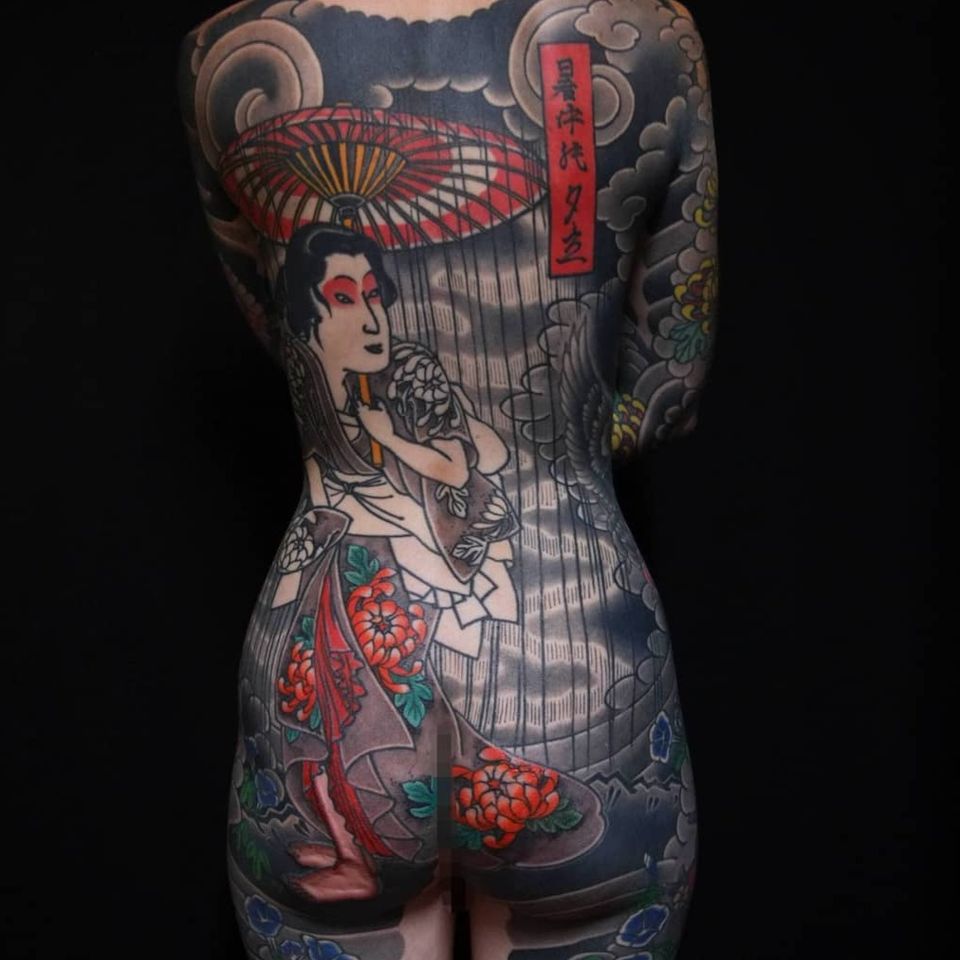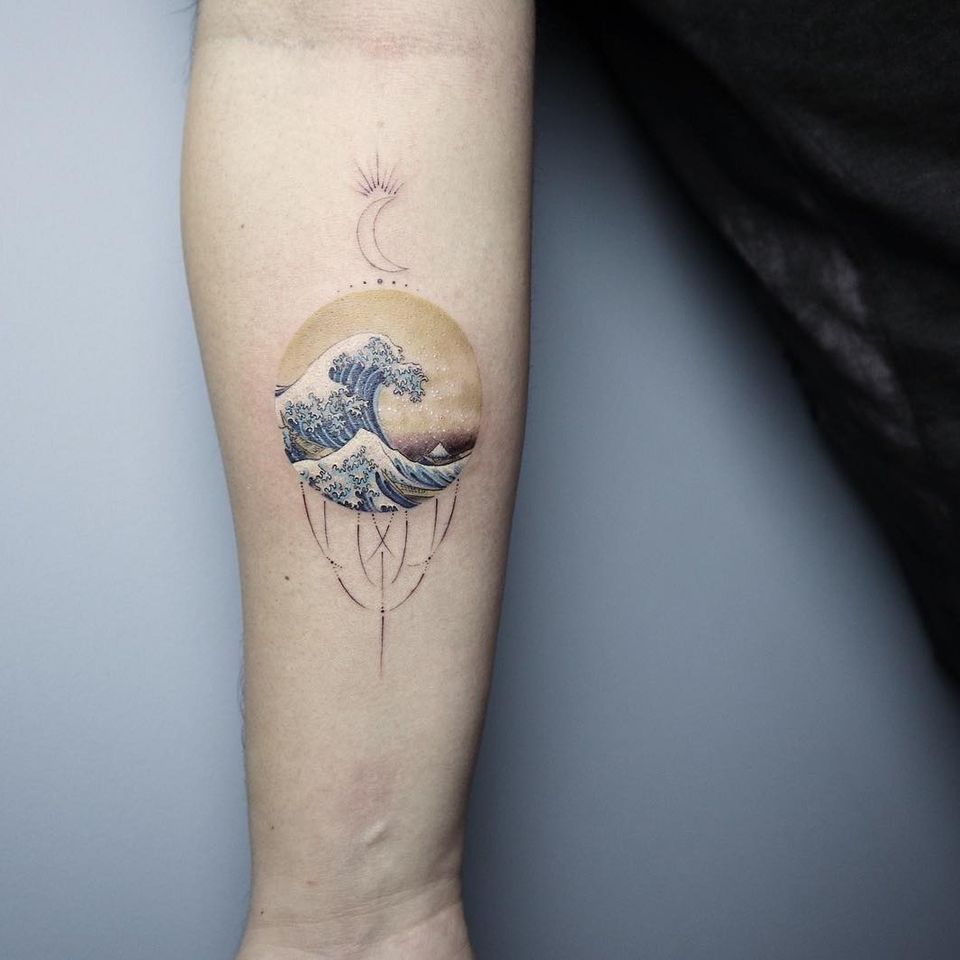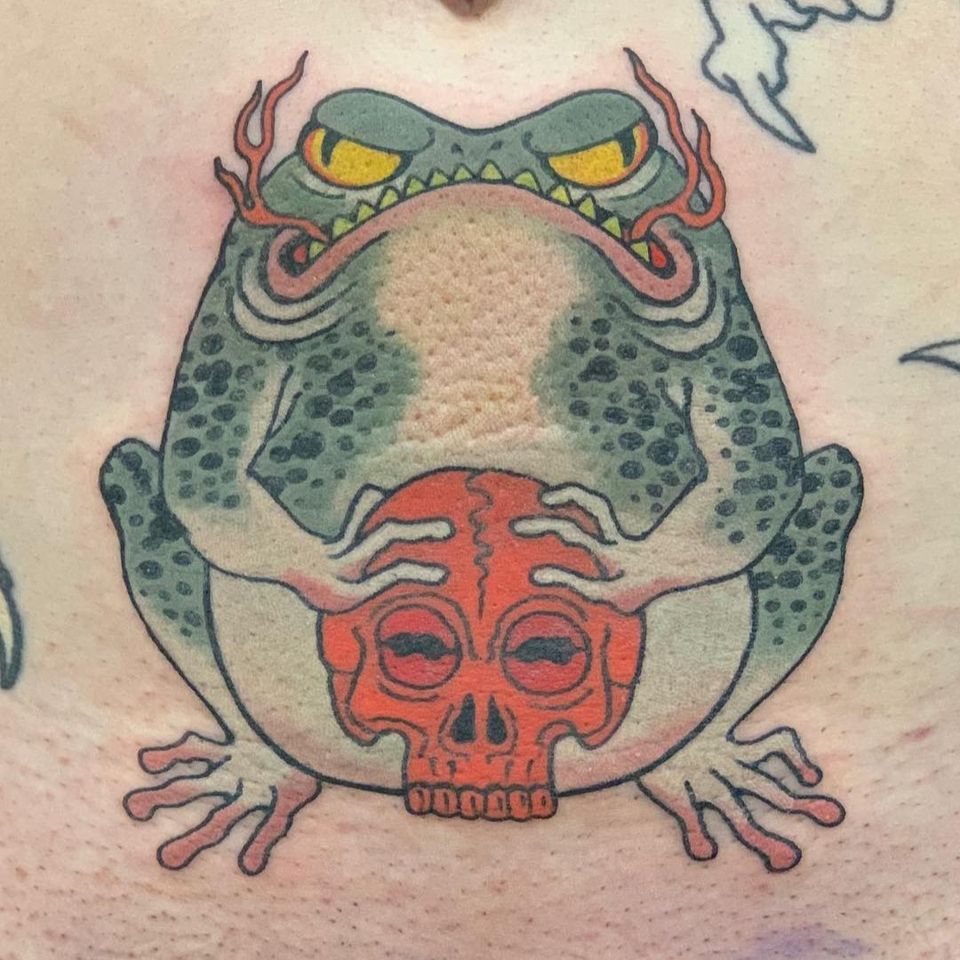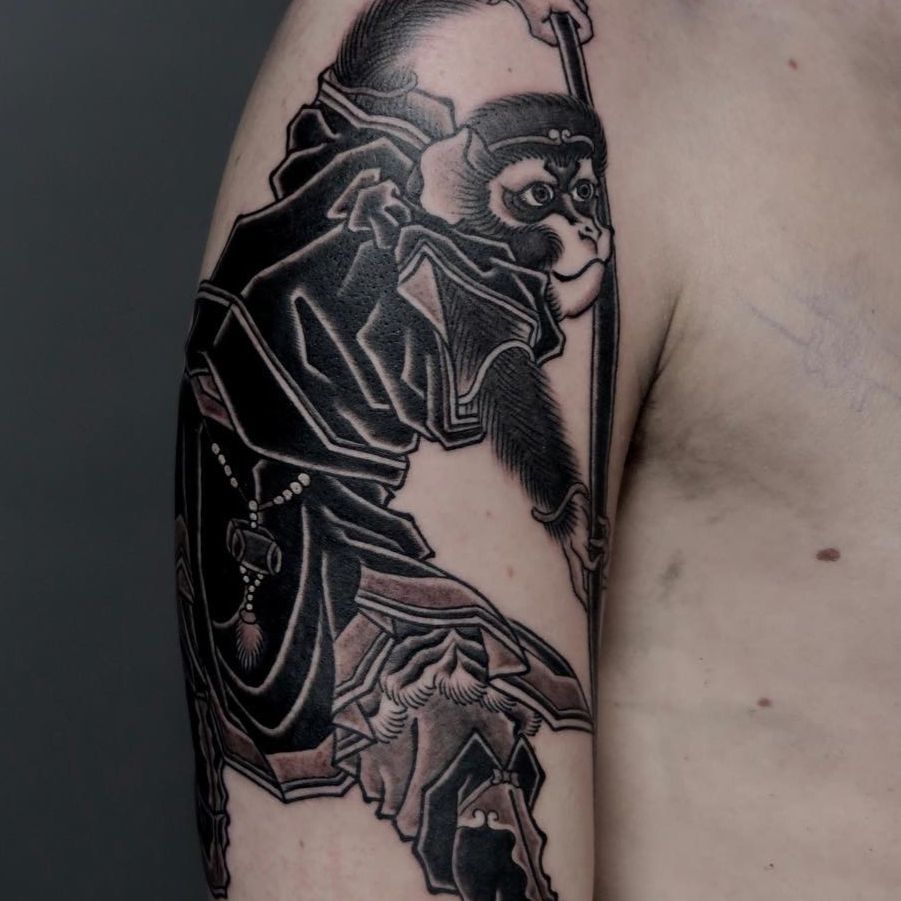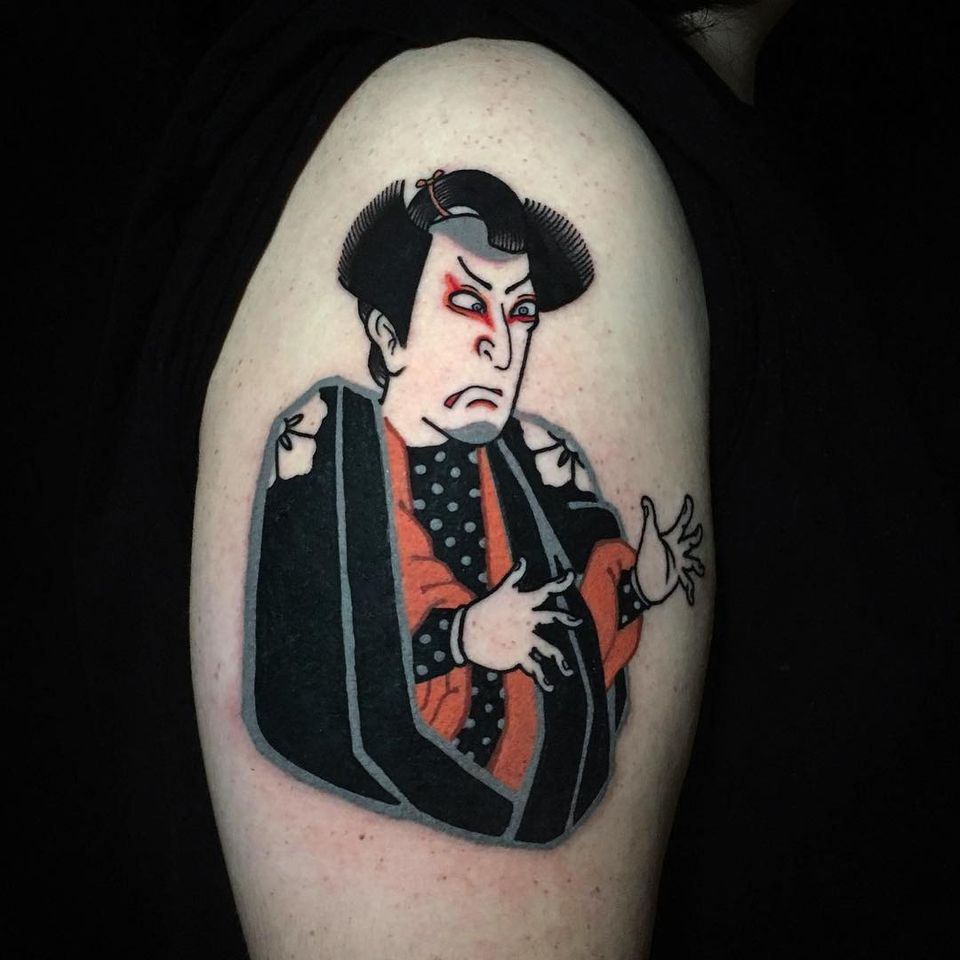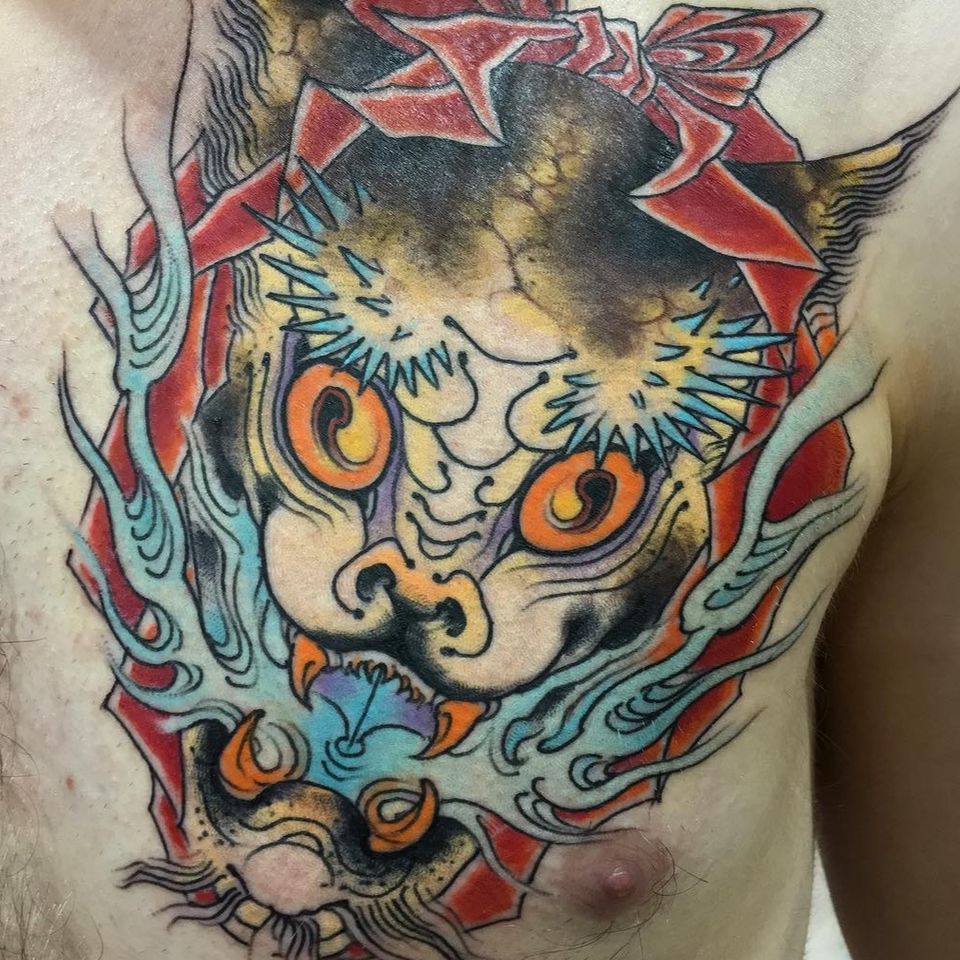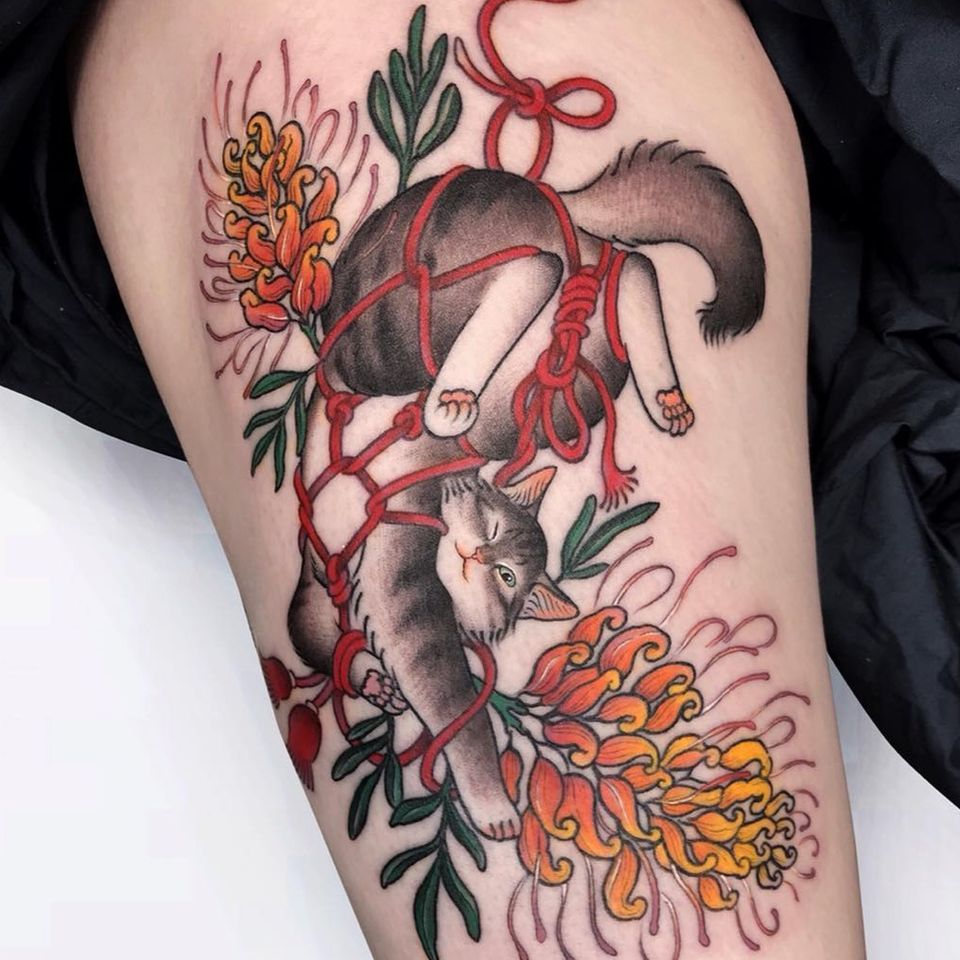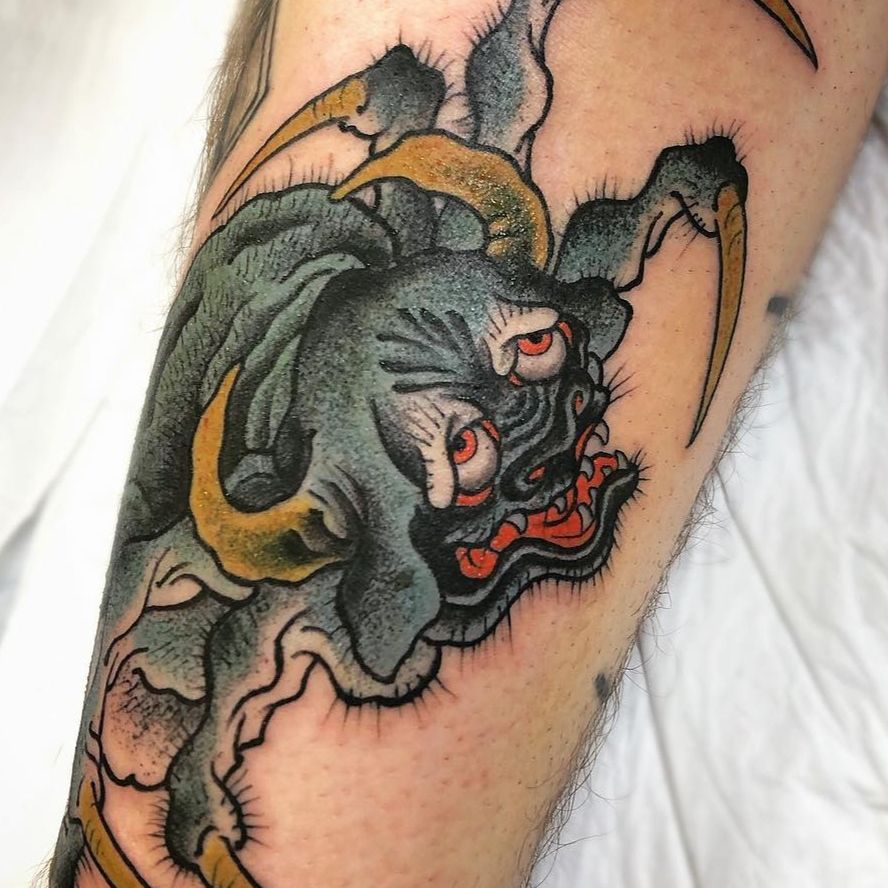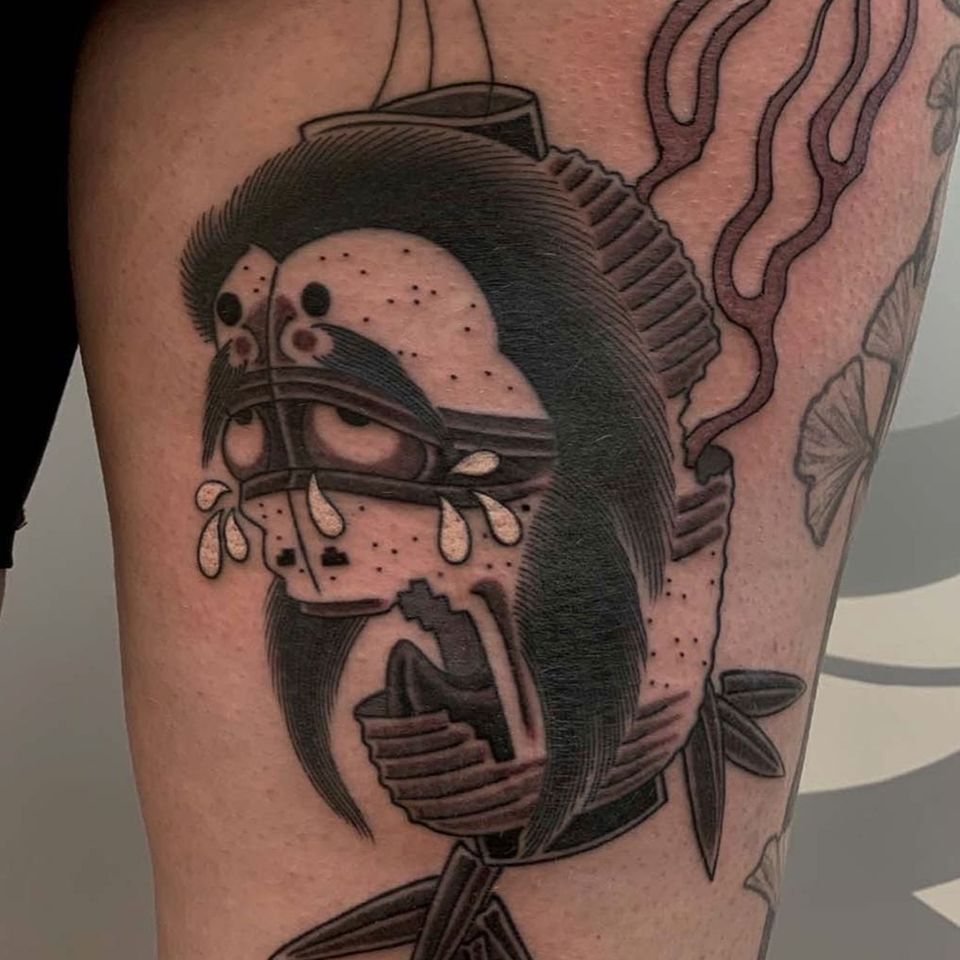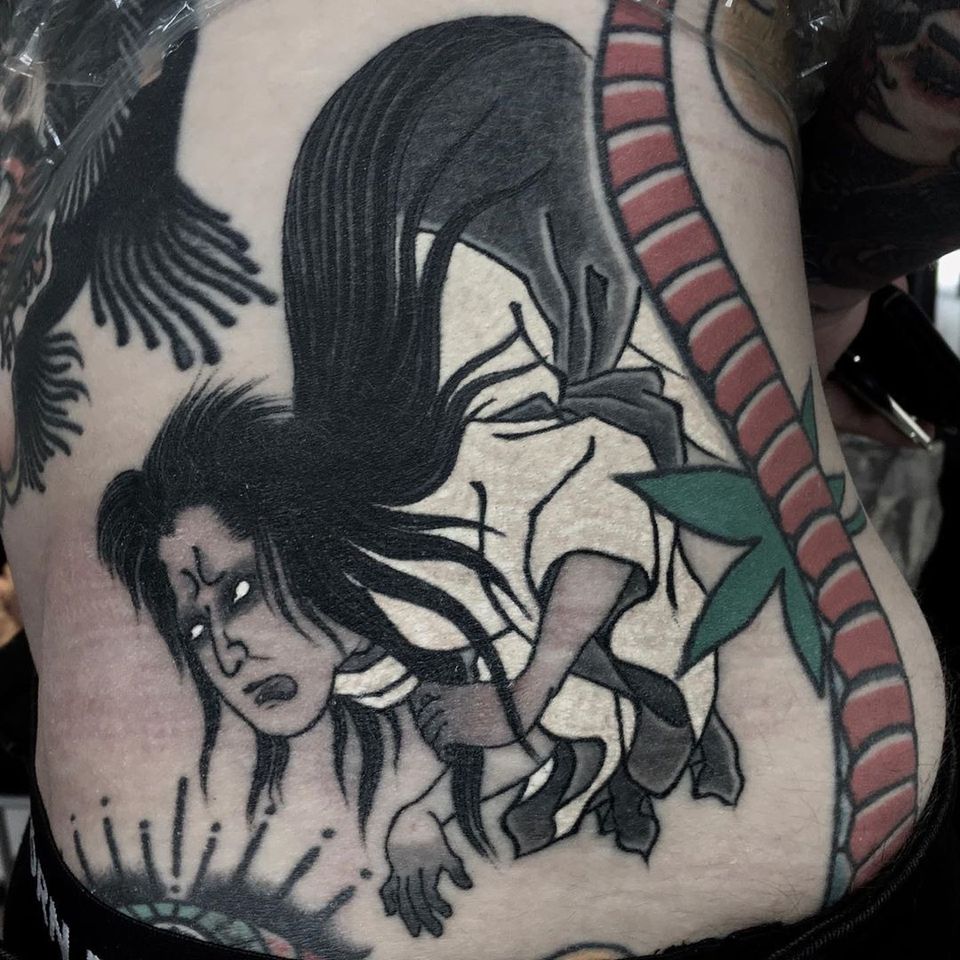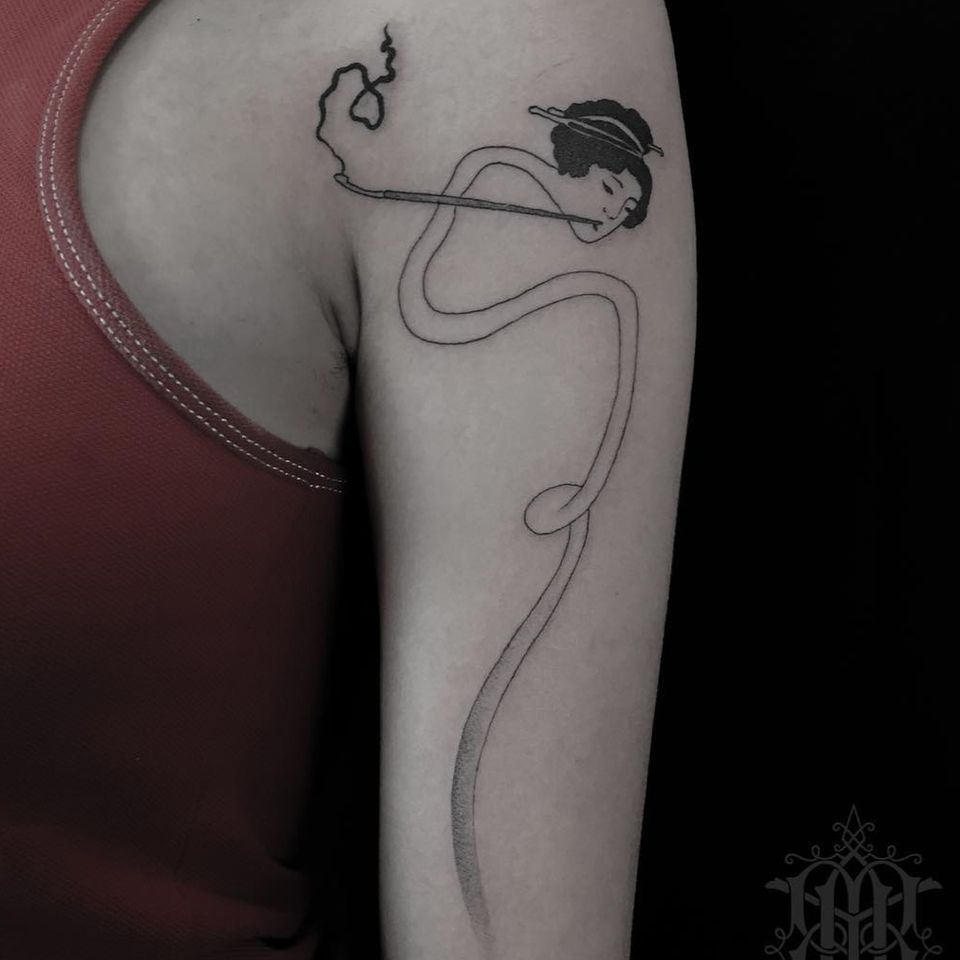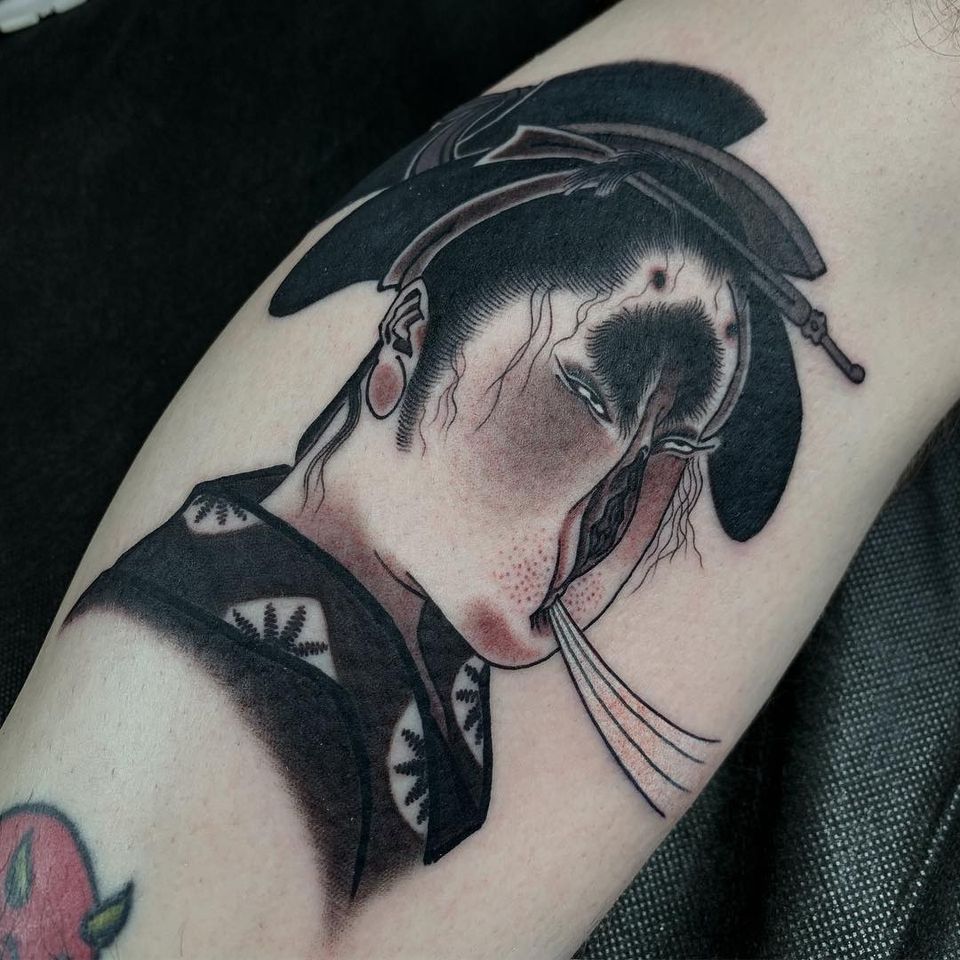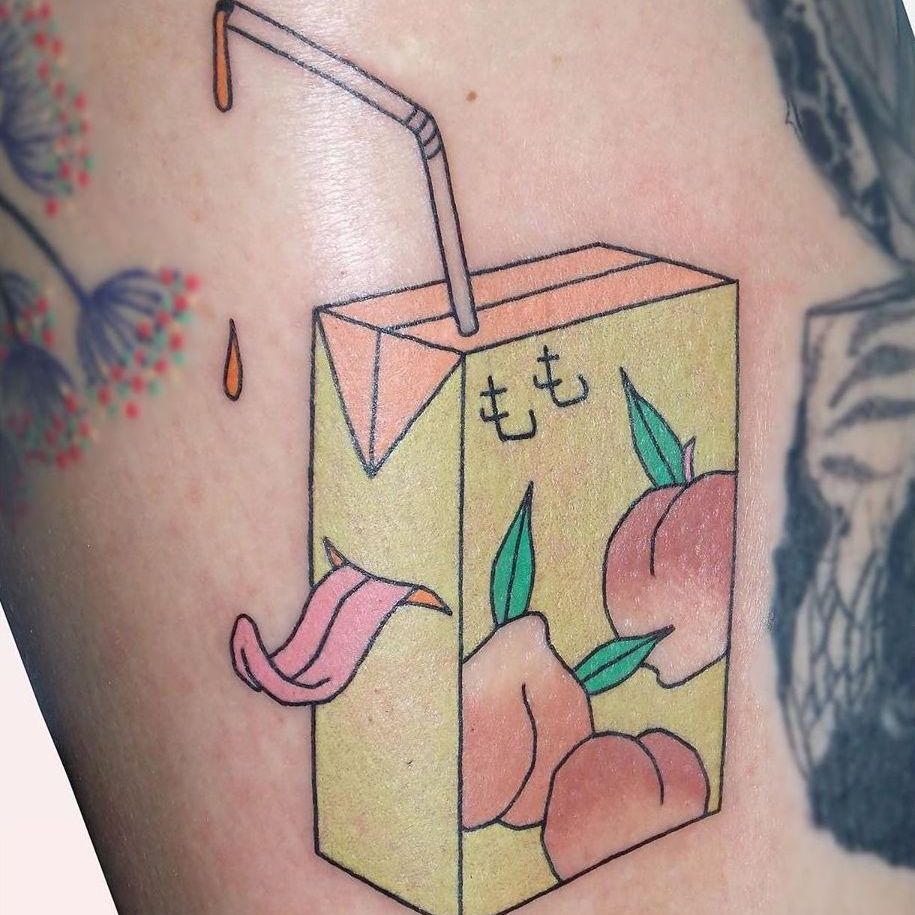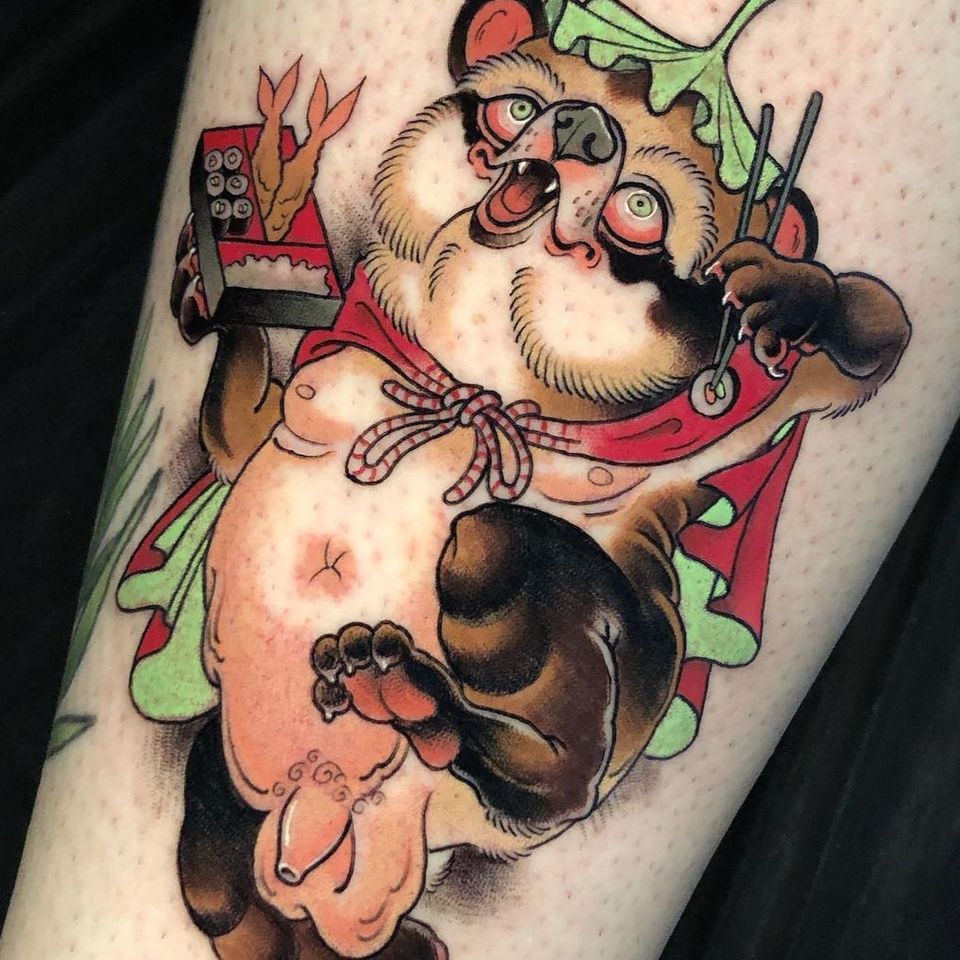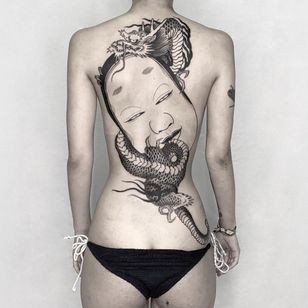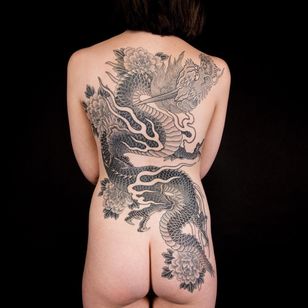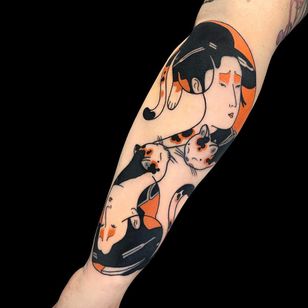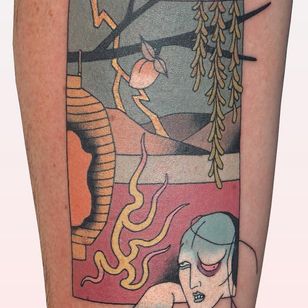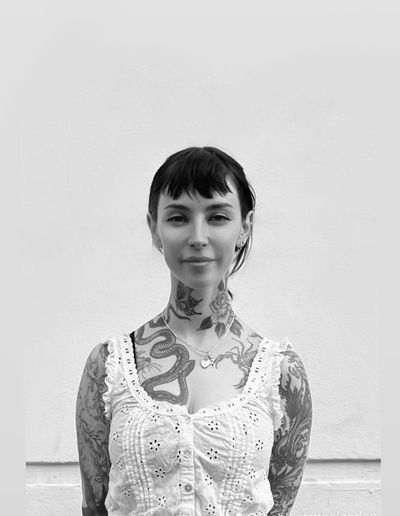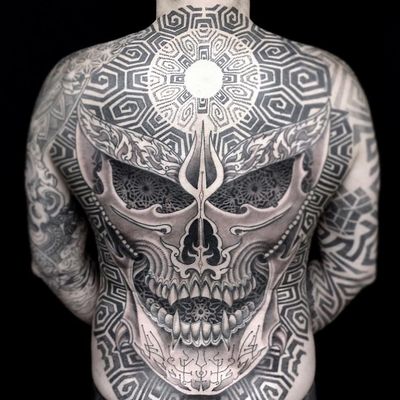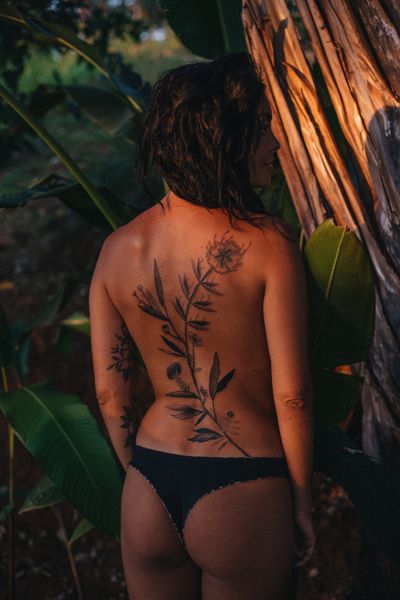An Intro to The Mythological Creatures of Japanese Irezumi

Ever wonder what all those creatures symbolize? You've come to the right place.
A mainstay of the tattoo community and culture, Japanese tattoos are culturally influential and illustrate a bevy of beautiful, terrifying, and downright mystifying creatures. Since there are so many characters within Japanese mythology and iconography, we figured we’d give you a list of the 50 top Japanese tattoo design motifs out there. Of course, there are literally thousands more but we hope this will be a primer for those of you are who interested in knowing more about the origins, characteristics, and meaning behind some of your favorite tattoo art.
1. Ryu Tattoo aka Japanese Dragon Tattoo
Arguably the most recognizable creature in Japanese iconography is the Dragon. Ryu are seen as a symbol of profound blessing, wisdom, and strength — due to their ability to manipulate the elements for the benefit of the people. Dragons tend to differ from one another as they are said to take on the characteristics of many creatures — typically depending on the animals it will encounter on its journey. His head is usually that of a camel, with the neck and belly of a snake, the scales of a koi fish, the talons of a hawk, chicken, or eagle, and the horns of a stag.
Read more about Ryu: Tremendous Traditional Japanese Dragon Tattoos
2. Tengu Tattoo
Tengu are a form of yōkai (supernatural creatures or ghosts). They are generally associated with themes of destruction and war. Though most commonly depicted as 'humanoid' nowadays, at one point, they were thought to take the form of birds of prey, hence the demonic creatures' long noses which evolved from their predecessors' beaks. Tengu are often illustrated as looking wrathful, and are frequently colored red to draw out their militant symbolism.
Read more: 12 Protective Tengu Tattoos
3. Kappa Tattoo aka Japanese Turtle Tattoo
The myth of this monstrous bipedal turtle derives from stories of giant salamanders who would reach out of shallow river beds to grab the unsuspecting with their powerful jaws. Kappa are notorious troublemakers and tricksters — who like peek up kimonos, kidnap children, and assault young females when they're least expecting it (what the hell?).
The Kappa's defining characteristic is a small cavity (or plate) of water located in its skull. When this cavity is dry he is powerless, so the answer to defeating a Kappa is to bow before him. Kappa apparently have a certain penchant for politeness — and will be compelled to bow back, thus spilling the water plate.
4. Fujin Tattoo
Fujin is commonly recognized as the Japanese deity of wind. He is most often depicted as an oni (demon-like) figure with skin of glowing green or blue and is believed to have powers similar to that of a wizard. The tapestry behind him is an enchanted object with which he controls air currents.
5. Raijin Tattoo
While Fujin is the god of wind, Raijin — his rival brother — is the Shinto deity of lightning and thunder. He is often depicted beating on drums to roar throughout the skies as thunderbolts fly off of his extremities. According to legend, the two brothers are combative in nature and stormy weather is a result of their endless squabbling.
Get more inspiration: 12 Thunderous Raijin Tattoos
6. Kirin Tattoo
The Kirin is another chimeral creature of Japanese folklore, and his rare appearance marks the passing of a sagely leader or ruler. Though its connotations of death seem like they would be sorrowful, this is not the case. The Kirin is seen as a good omen, signifying a better tomorrow achievable through the reflective process of mourning.
Kirin are traditionally rendered with the body of a deer, head of a dragon, the scales of a fish, hooves of a horse, mane of a lion, the tail of an ox, and a set of - or - single horn.
See more Kirin tattoo ideas: Traditional Japanese Tattoos of the Unicorn of the East - the Kirin
7. Baku Tattoo
According to legend, Baku are mythical creatures who aid in devouring nightmares. In Japan it is still common-place to see a Baku talisman near the bed, especially in a childs room. They are typically depicted with the head of an elephant, the claws of a tiger, the body of a bear, and the tail of an ox.
8. Karajishi Tattoo aka Foo Dog Tattoo
Often referred to as the "King of Beasts," Karajishi or "guardian lions" are another popular image from traditional Japanese folklore. Statues of these lion-like mythological creatures have traditionally been placed at the entrances of palaces and temples to chase away evil spirits, hence them being well-known symbols of courage as well as guardianship.
Get more Foo Dog tattoo ideas: Foo Dogs - The Mythological Lions of Traditional Japanese Tattoos
9. Koi Tattoo aka Japanese Fish Tattoo
These fish are native to Japan and have been a part of Japanese artistic culture for a very long time. They are symbolic of numerous things, but given their extraordinary lifespans, they are most commonly associated with longevity, persistence, and overcoming the trails of life.
Get inspired: 18 Killer Koi Fish Designs
10. Hou-ou Tattoo aka Japanese Phoenix Tattoo
In Japan, hou-ou or the phoenix is symbolic of the imperial household. This mythical bird represents a number of other things, including fidelity, fire, justice, obedience, and the sun. Interestingly, this fiery bird is both a figure of harmony and disharmony, descending from heaven at times of peace and fleeing back to its astral abode when strife inhabits the land. Because of this, it is seen as an emblem of new eras, whether they be better times or worse. In Irezumi, they are generally depicted as having avian physiology with particularly long necks and scales like snakes along with peacock tail-feathers.
11. Oni Tattoo aka Japanese Demon Tattoo
Oni are the the demons and devils of Japanese art. They are typically depicted as being largely humanoid minus their claws, fangs, horns, and often vibrantly colored skin. Oni are frequently illustrated as wearing loin cloths and wielding weapons such as katanas and kanabō — massive, studded clubs. These little demons are the harbingers of disaster, disease, and other things that plague humanity.
12. Kitsune Tattoo aka Japanese Fox Tattoo
Kitsune are revered as extremely intelligent creatures, rumored to be immortal as well as magical. According to some accounts they continue aging until they grow old enough to become Tenko — celestial foxes — and ascend into the heavens. They purportedly can shoot lightning and fire from their mouths, fly, and psychically will dreams into the minds of others. In other legends, they even have been reported as being shapeshifters that turn into humans to either find love or drain the life-force from unsuspecting mates.
See more designs of Japanese foxes: The Magical Folklore Behind Kitsune Tattoos
13. Hebi Tattoo aka Japanese Snake Tattoo
The hebi or snake have a wide range of symbolism in Japanese culture, but are often depicted as sharp-toothed guardian creatures that protect coveted riches and treasures. The snake can also symbolize rebirth, transformation, and the continual renewal of life.
14. Fudo Myoo Tattoo
Fudo Myoo, which in Japanese means "Wise King Acala," is a Buddhist deity that was imported into Irezumi's canon as the religion spread into the country. Though he has many interpretations, Fudo Myoo is generally seen as a wrathful protector, one who vanquishes spiritual impediments in order to help the faithful attain enlightenment. He is generally depicted as having an angry face with a wrinkled brow, pointy fangs, and squinted eyes. Traditionally, he holds numerous symbolic items, such as the three-pronged vajra sword and nooses.
15. Heikegani Tattoo aka Japanese Crab Tattoo
These disgruntled-looking crustaceans actually populate the beaches of Japan, and their backs really do look like scrunched-up angry faces. Though the Heikegani or "samurai crab" exists literally, their natural appearance has been borrowed into to Irezumi to figuratively represent the spirits of fallen warriors.
16. Nue Tattoo
This chimeric creature is straight out of The Tale of the Heike — the nearly a millennium-old Japanese epic poem. It is most commonly depicted as having an ape's face, the body of a tiger, and a snake for a tail. In the text, it describes a mysterious cloud of black smoke and a haunting voice. After the arrival of this ominous figure, the emperor at the time, Nijō, becomes seriously ill. Since no medicinal or spiritual remedies have any effect on him, he and his advisers deem it a curse brought on by the supernatural figure of the Nue. Nijō commands his best archer, Minamoto no Yorimasa, to go slay the beast. The archer's apprentice, Ino Haya, then takes one of his master's arrows, hunts down the Nue, and kills it, saving the emperor in the process.
More inspiration: The Legend of the Nue as Told Through Traditional Japanese Tattoos
17. Namakubi Tattoos
Not only a reminder of the impermanence of this life but an homage to the many great warriors and samurai of Japan’s history, Namakubi tattoos are images of severed heads. Usually covered in spots of blood, other details can include daggers, rope, and arrows. These images have their roots in the history of feudal Japan when serious wars were being fought and many honorable rituals were in place including Seppuku, often called Hari Kari. Used as both a suicide ceremony and capital punishment, Seppuku involved self-disembowelment followed by beheading. Namakubi tattoos are a grisly reminder of honorable actions, respect, courage, and overcoming fear.
Read more: Heads Will Roll - Namakubi Tattoos
18. Sakura: Cherry Blossom Tattoos
The Japanese have an immense respect for the natural world and the cycle of life it represents. Cherry blossom tattoos are a perfect embodiment of this. The Japanese have a history of practicing Buddhism and embracing impermanence is a large part of that. These beautiful flowers bloom and then wither usually in the space of 14 days. Cherry blossom tattoos usually capture them at their fullest, but they are still symbolic of the short, yet sweet, time we spend on Earth.
Read more: Cherry Blossom Tattoos - The Legend of the Sakura
19. Hannya Tattoos
Commonly used in Noh theater, Hannya masks are the faces of demonic females who have been cursed by their jealousy, obsession, and anger. Hannya tattoos are widely popular pieces to get not only because of their historical symbolism and depictions in Japanese culture but also because they’re visually captivating. Hannya’s can come in many different colors, but each one represents the social standing of the woman. A white Hannya tattoo illustrates a female of noble birth, while red denotes a provincial serf or peasant. The deepest shade of red, and black, is reserved for the darkest demons whose soul no longer remotely harks to the woman she used to be.
Read more: Never Cross a Jealous Female - Hannya Tattoos
20. Hitotsume-kozo Tattoos aka Tofu-kozo Tattoos
They may look like a cute bald-headed monk, but Hitotsume-kozo, or Tofu-kozo tattoos, are actually depictions of a specific goblin-like yokai that comes in the form of a mischievous child or “kozo”: a monk in training. Like a cyclops, Hitotsume-kozo have one eye in the center of their head but they’re mostly known for popping up when you least expect it with a little block of tofu on a plate! Unlike some of the other yokai on this list, Hitotsume-kozo tattoos are illustrations of a generally harmless little guy who is just looking for some fun.
Read more: Dishing Out Some Bean Curd with Tofu Boy Tattoos
21. Namazu Tattoo aka The Earthquake Catfish Tattoo
Namazu tattoos are inspired by the folktale of a giant catfish who hides under the mud waiting for the chance to cause earthquakes. Japan is frequented by earthquakes, so it makes sense that they would have a legend surrounding this horrific hazard. Namazu is guarded by Kashima, also known as Takemikazuchi, the god of thunder and swords. Often Namazu tattoos depict Kashima keeping the catfish under control with a giant stone but there are certainly other characters you’ll see swimming alongside this creature.
Read more: Traditional Tattoos of Namazu the Earthshaker
22. Botan Tattoos aka Peony Tattoos
Known as The King of Flowers, peony tattoos are highly regarded in Japanese mythology and culture. Known in Japan as “botan”, peonies have many metaphors surrounding them. Surprisingly enough, peony trees are not native to Japan and are thought to have been brought over from China by a Buddhist monk. A peony tattoo has many meanings that range from bravery, courage, honor, good fortune, romance, and prosperity. One of the most beautiful motifs of Japanese tattoos, a botan tattoo, or peony tattoo, is a wonderful addition to any Irezumi collection.
Read more: The Imperial Peony - Traditional Japanese Tattoos of Botan
23. Geisha Tattoos
Although like some of the motifs in this list are taken from folklore, Geisha tattoos depict one of the most famous aspects of Japanese culture and they are, as you know, quite real. But that doesn’t mean they don’t show up in some famous fairy tales and legends. Geisha have been known to be muses; they are the perfect epitome of an artful existence, which is something very inherent to much of Japanese life. Geisha tattoos are perhaps some of the most popular designs to get and it’s not hard to see why.
Read more: Geisha Tattoos - An Epitome of Grace and Beauty
24. Koinobori Tattoos
Fish have heavily influenced all parts of Japanese culture. From savory sushi to legends of earthquake causing catfish, Koinobori tattoos are another example of just how important sea and ocean-faring creatures are in Japan. These pieces actually depict a windsock, which is much like a flag. Many families, long ago, started to fly these on poles attached to their homes in honor of Boy’s Day, a festival celebrating sons. Although Boy’s Day still exists it has since evolved into a national holiday called Children’s Day since Koinobori tattoos still represent the vitality of children since carp and koi have so much energy they have no problem swimming upstream!
25. The Great Wave off Kanagawa - Japanese Wave Tattoos
Based on the famed Ukiyo-e woodblock print created by Hokusai, Japanese wave tattoos depict the work of art called “The Great Wave off Kanagawa”. Although this is perhaps the most well-known and reproduced image of his, there are actually 35 other images that are part of a series Hokusai created called “Thirty-six Views of Mount Fuji”. Many contemporary renditions that turn this print into a Japanese wave tattoo forego the detail of the mountain looming in the background. Mount Fuji is a source of national pride for many Japanese people, and the Great Wave framing it speaks to the majestic beauty and strength of nature.
Read more: Riding the Rip Tide - Hokusai’s Great Wave Tattoos
26. Kasa-obake Tattoos: The Umbrella Demon
A perfect example of how traditional Japanese values and ideas develop into imagery, Kasa-obake tattoos are umbrellas that have turned into demons. In Shintoism, ordinary objects will gather what is called “kami” or spirit over time; these objects are then called Tsukumogami. Apparently, the legend goes that this happens on the household tools 100th birthday, wherein they have lived for so long that they are now endowed with awareness. Many Kasa-obake tattoos are actually taken from a famous film called “Yokai Monsters: 100 Monsters” from 1968. Mostly a funny, quirky, and mischevious character, Kasa-obake tattoos are perfect for people who love the humorous bits of Japanese culture.
Read more: A Most Infamous Yokai - Kasa-obake Tattoos
27. Jorogumo Tattoos - The Spider Woman
Jorogumo tattoos have a fascinating history that spans many different legends and stories; some are even specific to the location and geography of Japan. This particular Japanese icon is a demon that can morph from a Spider Woman into a beguiling lady who charms her victims with beauty. However, some Jorogumo tattoos are actually based on the scenic waterfall Kashikobuchi located in Sendai, Japan. The Spider Woman in the legend of Kashikobuchi is actually worshipped for her power to fend off water disasters...but be warned, she’ll still kill you if she gets the chance.
Read more: Binding Brides - Traditional Japanese Tattoos of Jorogumo
28. Japanese Toad Tattoos
If you haven’t already guessed, natural life is a very important aspect of Japanese life, as well as Japanese mythology, so much of the iconography within the folktales uses animals as a key character. Japanese toad tattoos are a great example of this, and an awesome addition to any Irezumi tattoo collection. Often, Japanese toad tattoos are symbols of prosperity, wealth, success, and good luck, which is why you may see a toad tattoo that includes gold coins.
29. Saru Tattoos aka Japanese Monkey Tattoos
Another animal that has become a key figure in many legends and stories, Saru tattoos, also known as Japanese monkey tattoos, depict the cunning creature that all of us know and love. Saru tattoos usually come in the form of Noh masks, but they can also be confused for Son-gyoja, the Japanese version of the Monkey King. The meaning and feeling about monkeys has changed over the years in Japan. In the 8th century, they were thought of as mediators between gods and humans but were later thought of as obnoxious little tricksters.
Read more: Charismatic Japanese Saru Tattoos
30. Kabuki Theatre Tattoos
Dramatic musical theatre in Japan is much different than what you will experience in the west, but be assured, there’s still lavish costumes, make-up, and dramatic plots involved. In the 1600s women were the main performers and their exhibitions often involved risque scenarios. To make it even sexier, many of the performers in Kabuki theatre at that time were also prostitutes. The contemporary dance-drama has certainly evolved from its beginnings and many Kabuki Theatre tattoos concentrate on the elaborate costumes and make-up.
Read more: 10 Gorgeous Tattoos Inspired by Japanese Kabuki Theater
31. Other Japanese Mask Tattoos
Japanese culture is actually filled with masks, so there is tons of inspiration out there if you’re looking to get your own Japanese mask tattoo. Although Hannya’s may be the most popular and well-known, there are many other characters that have been used to create costumes. From Kitsune to Okame, if you dig a little deep into Noh, Kabuki, legends, and folklore, there may be something in particular that can influence the design of your Japanese mask tattoo.
Read more: 20 Theatrical Japanese Mask Tattoos
32. Maneki Neko Tattoos - Japanese Cat Tattoos
Almost as iconic as Hello Kitty herself, Maneki Neko tattoos are illustrations of the lucky cat. Maneki Neko actually means “beckoning cat”, and it’s cute little upraised paw is meant to bring in fortune, wealth, and luck. You’ve probably seen this little guy sitting in the corner of your favorite Japanese or Chinese restaurant holding a gold coin. Maneki Neko tattoos are actually just one of the many Japanese cat tattoos you can get. The Japanese love their cats, so kitties will often be characters in mythology, folklore, and children’s stories.
Read more: 8 Lucky Maneki Neko Tattoos
33. Kintaro Tattoos
Directly translated as “Golden Boy” Kintaro tattoos are a nod to a famed legend of a young boy who became a hero by catching evil oni and more. There are many stories about this character, but perhaps the best origination story is the one where his mother was impregnated by a clap of thunder sent from a red dragon, which would explain his indefatigable strength, energy, and power. Many Kintaro tattoos show him with a giant carp, which comes from another folktale where he goes underwater to capture a trouble-making koi.
Read more: Ride the Koi With These Kintaro Tattoos
34. Yokai Tattoos
We’ve already mentioned many of them in this list, but Yokai tattoos are supernatural ghosts, demons, and spirits. They can range from deeply evil to kinda cute, but the great thing about yokai tattoos is that there are so many different ones to choose from. If you’re as in love with Japanese tattoos as we are, our advice is to dig in, read some fairytales, and choose a yokai tattoo that resonates with you. Each of them has their very own personality, specific powers, and they usually have a fascinating backstory, so make it fun and figure out which one is yours!
Read more: Supernatural Spirits and Spectres - Yokai Tattoos
35. Monmon Cat Tattoos
With over twenty years of experience, Horitomo is a highly respected Japanese tattooer who owns State of Grace Tattoos in San Jose, California. Because Horitomo is deeply in love with tattooing and cats, it made sense to bring the two together to create Monmon cat tattoos. Our favorites include one tattooed cat giving another kitty a tebori tattoo, but there are so many different lil kitties in his collection, and he’s always coming up with more! He’s even included some tatted up mice just in case your cat needs a friend...or a snack.
Read more: A Chat with the Master of Monmon Cats
36. Hyottoko Tattoos
Hyottoko tattoos usually come in the form of masks. He’s a very popular character that is the comedian of the theatre biz, but his legend goes quite far back into history. Originally he is actually known as the god of fire, and at times you’ll see Hyottoko tattoos that have a bamboo pipe stuck into his skewed mouth that blows fire! This piece is definitely best for those who not only love aspects of Japanese mythology and folklore but who also may be a class clown.
Read more: Hyottoko Tattoos - Homage to Humor
37. Bakeneko Tattoos and Nekomata Tattoos
Another cat within the insanely large and varied world of Japanese cat legends is that of Bakeneko, also known as Nekomata. Bakeneko tattoos and Nekomata tattoos are visual representations of yokai that have many different characteristics depending on the story your kitty comes from. Some of them can shapeshift into women, some drink blood, and others are just simply exactly like an ordinary house cat: difficult to control, very clever, and they have many nocturnal activities to keep them busy. Keep in mind that Bakeneko tattoos and Nekomata tattoos have one main difference: Nekomata have two tails, while Bakeneko only has one.
38. Shibari Tattoos
You may have seen images of women being tied into what look to be rather uncomfortable positions. These Japanese tattoos are based on the ancient art of rope tying. Recently shibari has exploded in popularity around the world resulting in a surge of clever shibari tattoos. We’ve seen lovely ladies, cats, and even roses depicted in knots, and although shibari isn’t directly related to mythology, there are many legends of evil demons torturing their victims by tying them to bamboo poles. Whether your shibari tattoo is beautiful or brutal, we’re sure this will resonate with some of the kinkier folk out there.
Read more: Power Play is Sexier with Consent: Shibari Tattoos
39. Momotaro Tattoos
One of the cutest characters in Japanese mythology, Momotaro tattoos are portraits of the Peach Boy! There are actually a few different tales of children popping out of random things in order to give a childless couple the opportunity to be parents, including The Tale of the Bamboo Cutter which was remade into the Studio Ghibli film The Tale of Princess Kaguya. The story of Momotaro is similar but unlike Kaguya, Momotaro went on to become a hero who destroys a band of oni ravaging the surrounding lands of his home. Momotaro tattoos are a playful and colorful addition to any Japanese tattoo collection.
40. Daruma Tattoos
Although Daruma tattoos may not strike you as a depiction of a revered holy man, Daruma dolls are, in fact, modeled after Bodhidharma who founded the Zen Buddhism tradition in Japan. These hollow little round dolls are a favorite Japanese tattoo as well as a toy, talisman, and gift of encouragement. They symbolize good luck and perseverance partly because, legend has it, that Bodhidharma was so dedicated to his Buddhist lifestyle that once after falling asleep during meditation he cut off his own eyelids so that it would never happen again. There’s also a story that once he sat for nine years staring at a wall. After he was finished, he could no longer stand up because his legs had atrophied which is why Daruma dolls, and Daruma doll tattoos, do not have legs.
Read more: 16 Awesome Daruma Doll Tattoos
41. Ushi-Oni Tattoos
Most Ushi-oni tattoos look a bit like a spider with the head of a very stoned or sleepy oxen. But don’t let that fool you. Ushi-oni are demonic yokai who prefer to snack on human flesh. It’s good to note that depending on the geographical location, the characteristics of this particular yokai actually change, but they all have bovine and oni features but pretty much every legend that includes a Ushi-oni agrees that they live in water and feed on unsuspecting humans lounging on beaches.
42. Chochin-obake Tattoos
Like Kasa-obake, Chochin-obake is an ordinary household item that has survived long enough to be endowed with ‘kami’ or spirit. The paper lantern is an extremely typical item in Japan, and you will see them swinging from many doors and roofs while walking around the prefectures. Most people believe that these particular yokai grew faces once the paper the lantern was made of split from years of use; a tear would become a mouth with a long tongue protruding from it. Chochin-obake tattoos are very popular, so if you’re interested in Japanese tattoos, you’ve probably seen one before.
43. Yurei Tattoos
Yurei tattoos are depictions of what a Westerner would consider most closely to resemble a ghost. Similar to Chinese and Western ideas of spirits, Yurei are thought to be the spirit of someone who is kept from a peaceful afterlife. This can happen if the person has committed suicide, has been murdered, or if the final rites of their burial were not properly carried out. Most often, Yurei tattoos will look exactly like what their name means: a faint spirit or a dim soul.
Read more: 10 Haunting Yurei Tattoos
44. Crane Tattoos
Another extremely popular element of Japanese tattoos, crane tattoos hold an incredible amount of deep and sacred symbolism. They are highly revered in Japan and referred to as the “bird of happiness”. Crane tattoos are symbols of longevity, as well as good fortune, and are thought to live for thousands of years. Cranes are found in many different Japanese mythological stories and folktales, so adding one to your Irezumi collection may not be a bad idea.
Read more: Eternal Youth and Lasting Happiness - Crane Tattoo Symbolism
45. Akkorokamui Tattoos
This gigantic octopus-like monster lurks in the shores of Hokkaido and is deeply respected by the Ainu, an indigenous people from Japan and Russia. Akkorokamui tattoos will usually look exactly like an octopus, but may have details denoting its great size. One interesting characteristic of this particular mythological creature is that it can, like many species of octopi, self-amputate limbs and then regrow them if needed. Because of this, the Ainu believe that Akkorokamui has healing powers, especially for those with broken, severed, or disfigured limbs.
46. Rokurokubi Tattoos
Like we mentioned before if you’re deeply interested in Japanese tattoos and the mythology behind them, it may be a great idea to check out the late 60s film “Yokai Monsters: 100 Monsters”. This is where you’ll meet many yokai including Rokurokubi. These yokai are usually beautiful women who are also demons that can make their neck stretch like a snake. Another type of Rokurokubi is a nukekubi, which can pop their head completely off so that it can freely fly around the room.
47. Shunga Tattoos
If you haven’t been introduced to Shunga by now, let us help you out. Shunga is ancient erotica...basically Japanese woodblock porn. Many Japanese tattoos are influenced by the many incredible works of Ukiyo-e and in this case, it’s no different. Shunga tattoos have become increasingly popular and, believe it or not, many of them are inspired by the famed artist Hokusai. One of the most famous myths was brought into visual art reality by that particular master and goes by the name of “The Dream of the Fishermans Wife”. Perhaps tentacle porn isn’t exactly your thing but in the world of Shunga, nothing is off limits.
48. Peach Tattoos
Like many other flora and fauna, the fruits of Japan also carry their own special symbolism. Peach tattoos, like the juicy food they depict, are associated with the elimination of evil and misfortune as well as long life. Unlike Western peaches, Japanese peaches are very large, about the size of a small grapefruit, and are usually white or light pink in color. But, beware, Japanese peaches should be peeled before eating them as their soft skin is slightly prickly.
Read more: What’s Soft and Fuzzy and Round All Over? Peach Tattoos
49. Tanuki Tattoos
Ah, the clever and mischevious little Japanese raccoon dog. A Tanuki is a sub-species of Asian raccoon dogs that has had a long history within the annals of Japanese mythology. Most often a Tanuki tattoo is actually an illustration of a Bake-danuki, a yokai with supernatural powers, rather than the actual real-life animal. They are generally thought of as jolly, naughty, with a penchant for disguising themselves as teapots, monks, and a variety of other random things. But that’s okay because as much trouble as they may cause, they’re actually a bit slow and stupid. Tanuki tattoos are usually drawn up sporting a smile while playing with their gigantic balls. And, no, we’re not joking.
Read more: 8 Cute Tanuki Tattoos
50. Torii Tattoos
Our last important Japanese mythological design icon is one that you can see all around Japan. Torii tattoos are visual representations of torii, gates that mark the entrance into a sacred or spiritual place. Usually, they are painted red which is a colour symbolizing protection against evil. They are typically found directly in front of Shinto shrines, but you can also find them dotted amongst Japanese landscapes such as in forests or resting in water such as the famous Itsukushima Shrine “floating” torii. Perhaps the most well-known torii collection is that of Fushimi Inari which has a collection of over 30,000 torii gates. Getting a torii tattoo is an incredibly special piece to collect, especially if you are a spiritual person.
If you’ve read this far we assume you’re pretty interested in the monsters, spirits, and spectres of Japanese mythology. If you’d like to read more about this particular aspect of Japanese tattoos we’d suggest checking out “Dream Spectres” which is part of a series of books that highlights various Japanese artworks and the myths or characters within them. We also have an article about Ero Guro, which is a fascinating art movement that is also still influential to tattooing today. Another suggestion would be to peruse the images of the “He-Gassen”, which is a 200 year old, 34 foot long scroll with illustrations depicting “the fart wars”.
If you’re less into reading and more into experiencing, then perhaps a Japanese monster movie night is the perfect thing. There are so many films out there but our favorites happen to be Kwaidan, Hausu, Kuroneko, Spirited Away, and A Letter to Momo.
We hope this collection has inspired you and that you’ll think about adding one of these unique creatures to your own Japanese tattoo collection.

